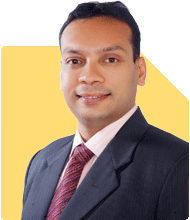Ramalingam Kalirajan |6501 Answers |Ask -Follow
Mutual Funds, Financial Planning Expert - Answered on Jul 06, 2024
He has an MBA in finance from the University of Madras and is a certified financial planner.
He is the director and chief financial planner at Holistic Investment, a Chennai-based firm that offers financial planning and wealth management advice.... more

If i invest lumpsum 13 Lakhs in stocks both US and India 50% each and a 10k sip every month no step up sip how much time will it take to reach 1Cr
Understanding the Power of Lumpsum and SIP Investments
Lumpsum investments allow you to take advantage of market opportunities immediately. With Rs. 13 lakhs, split equally between US and Indian stocks, you're diversifying your investment across geographies, which can potentially reduce risk and enhance returns.
SIPs, or Systematic Investment Plans, are a disciplined approach to investing. Investing Rs. 10,000 monthly allows you to benefit from rupee cost averaging, where you buy more units when prices are low and fewer units when prices are high. This can smooth out market volatility over time.
The Potential of Diversification
Investing in both US and Indian stocks provides geographical diversification. The US market, being one of the largest and most liquid, offers exposure to global companies and sectors that might not be available in the Indian market. Indian stocks, on the other hand, provide exposure to one of the fastest-growing economies.
This diversification can potentially reduce the risk and increase the chance of achieving your financial goals.
Market Performance and Expected Returns
Historical data shows that both US and Indian stock markets have provided substantial returns over the long term. However, it's important to note that past performance is not indicative of future results.
For this exercise, let's consider an average annual return of 12% from your mixed portfolio. This is a conservative estimate considering the long-term performance of equity markets.
Compounding Effect
Compounding is the process where the earnings from your investments generate their own earnings. The longer your money remains invested, the more it can grow due to compounding.
By investing Rs. 13 lakhs upfront and adding Rs. 10,000 monthly, you're creating multiple opportunities for compounding, enhancing the growth potential of your investments.
Risk and Reward
Equity investments are inherently risky, but they also offer the potential for higher returns compared to other asset classes. By diversifying across US and Indian stocks, you're spreading the risk, which can help mitigate potential downsides.
However, it's crucial to stay invested for the long term and avoid reacting to short-term market fluctuations.
Role of Mutual Funds
Mutual funds can play a vital role in achieving your investment goals. They offer professional management and diversification. Actively managed funds, in particular, have fund managers who make investment decisions to beat the market benchmarks.
These funds can be a good complement to your direct stock investments.
SIP Benefits in Mutual Funds
SIPs in mutual funds offer several advantages. They promote disciplined investing, reduce the impact of market volatility, and take advantage of the power of compounding.
Even without a step-up SIP, consistent investing can significantly grow your corpus over time.
Time Horizon to Reach Rs. 1 Crore
Based on a conservative estimate of 12% annual return, let's assess the time it might take to reach Rs. 1 crore.
Assuming your Rs. 13 lakhs grows at an annual rate of 12%, and adding Rs. 10,000 every month, your investments can grow substantially.
Monitoring and Reviewing Your Investments
Regularly monitoring and reviewing your investments is crucial. Market conditions and personal financial goals may change, and it's important to adjust your portfolio accordingly.
Working with a Certified Financial Planner can help ensure your investment strategy remains aligned with your goals.
Importance of Staying Invested
Staying invested for the long term is key to achieving your financial goals. Equity markets can be volatile, but over the long term, they have the potential to provide significant returns.
Avoid the temptation to withdraw funds during market downturns, as this can hamper the compounding effect.
The Role of Asset Allocation
Proper asset allocation is essential in managing risk and maximizing returns. By allocating your investments across different asset classes, such as US and Indian stocks, mutual funds, and others, you can balance the risk and return in your portfolio.
Tax Considerations
Investing in US stocks involves understanding the tax implications, as they may be different from investing in Indian stocks.
It's important to consider the tax impact on your overall returns and work with a tax advisor if needed.
Regular Investment Plans
Continuing your SIPs and periodically investing lumpsum amounts when possible can enhance your investment portfolio. This approach ensures that you are consistently investing, regardless of market conditions.
The Impact of Market Fluctuations
Market fluctuations are a normal part of investing. They can create opportunities for buying at lower prices and can also test your patience and discipline.
It's important to remain focused on your long-term goals and avoid making impulsive decisions based on short-term market movements.
Assessing Fund Performance
For mutual fund investments, regularly assess the performance of the funds. Look at factors such as fund manager performance, expense ratios, and consistency in returns.
This helps ensure that your funds are performing as expected and contributing to your financial goals.
Conclusion
Reaching Rs. 1 crore with a combination of lumpsum and SIP investments in US and Indian stocks is achievable. It requires a disciplined approach, regular monitoring, and staying invested for the long term.
Understanding the power of compounding, diversification, and the benefits of mutual funds can help you achieve your financial goals.
Best Regards,
K. Ramalingam, MBA, CFP
Chief Financial Planner
www.holisticinvestment.in
You may like to see similar questions and answers below
Ramalingam Kalirajan |6501 Answers |Ask -Follow
Mutual Funds, Financial Planning Expert - Answered on Apr 30, 2024
Ramalingam Kalirajan |6501 Answers |Ask -Follow
Mutual Funds, Financial Planning Expert - Answered on May 01, 2024
Ramalingam Kalirajan |6501 Answers |Ask -Follow
Mutual Funds, Financial Planning Expert - Answered on Jun 23, 2024
Dr Dipankar Dutta |653 Answers |Ask -Follow
Tech Careers and Skill Development Expert - Answered on Oct 04, 2024
Krishna Kumar |377 Answers |Ask -Follow
Workplace Expert - Answered on Oct 04, 2024
Krishna Kumar |377 Answers |Ask -Follow
Workplace Expert - Answered on Oct 04, 2024
Krishna Kumar |377 Answers |Ask -Follow
Workplace Expert - Answered on Oct 04, 2024
Krishna Kumar |377 Answers |Ask -Follow
Workplace Expert - Answered on Oct 04, 2024
Krishna Kumar |377 Answers |Ask -Follow
Workplace Expert - Answered on Oct 04, 2024
Krishna Kumar |377 Answers |Ask -Follow
Workplace Expert - Answered on Oct 04, 2024
Krishna Kumar |377 Answers |Ask -Follow
Workplace Expert - Answered on Oct 04, 2024
Krishna Kumar |377 Answers |Ask -Follow
Workplace Expert - Answered on Oct 04, 2024
Krishna Kumar |377 Answers |Ask -Follow
Workplace Expert - Answered on Oct 04, 2024






















